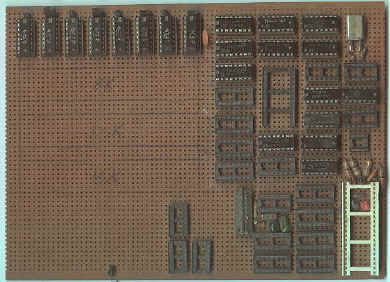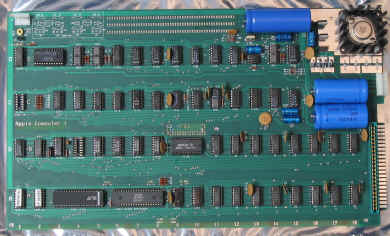|
Mark-8 Minicomputer
Apple-1
MOS Kim-1
V C F
Imsai 8080
Kenbak-1
TV Typewriter
LSI ADM-3A
ASR-33
The Digital Group
My Collection
HP-01
Test Equipment
Model Rocketry
| |
| |
|
| Home Made Apple-1
Back around 1977, I ran across plans by Steve Wozniak, AKA Woz, for the
Apple-1 computer. I had the chips, and the time, so why not? This is what
I built. I no longer have the set of plans I used, I have no idea what
became of them. The project took me about a month to complete, and though
I populated the board with chips and made sections of it run perfectly, as
a whole, it didn't work well, and I soon abandoned the project. If I
recall, I suspected the problems were with the surplus dynamic RAMs, but
looking back on it, I also took some shortcuts in my construction for lack
of cash to do it right. For example, all of the parts were used or surplus
(even the IC sockets). I did make an off board 1K static RAM board that
worked better, but I had to rob the chips from my Digital Group computer
to populate it, and I valued that computer far more. It was fun while it
lasted.
|

Homebrew Apple 1 Computer, circa 1977.
|
| The Circuit
The Apple-1 was an ingenious design that
was very unique for the day. Based on the MOS Technology 6502, it was
probably the first hobby computer to ever be designed by a real
electronics engineer.
The Apple-1 used dynamic RAM, a far more economical memory than static
RAM, but very hard to use. Dynamic RAM required "refreshing"
every 2 ms. This was a heavy burden for an early microprocessor, requiring
special timing and controllers to stop or pause the processor long enough
to complete a refresh cycle 500 times a second. Almost no one could make
it work the first time. Miss a beat, and you lose most or all your data.
(I remember MITS had many problems with their attempt, and although the
Digital Group version worked fine, a few modifications were required to
the CPU and other boards to make it work.)
Woz made it work. The Apple-1 used the same clock signal to refresh the
RAM, out clock the video and run the processor. It worked perfectly, and
made history.
My home built version had several other differences from the Woz's
Apple-1, I already had a nice video card as part of my Digital Group
system, so I didn't build one on board. I also didn't have access to the
ROM listings, so I made my own boot ROM to load programs by keyboard. I
also made other modifications, but I no longer remember what they were or
why I made them...
That's all I can remember about the homebrew!
|
| The Replicas
There have been a number of Apple-1 replicas built in recent years, the
Replica-1 built by
Vince Briel is probably the most available of all Apple-1 replicas. I
even took home a Replica-1 as a prize at the VCF a
few years ago. Sweet. In 2005, Steve Gabaly of Apalacia, NY, made the
most faithful Apple-1 replica to date. Steve owned an Apple-1, and used it
as a model to make a near photographical and functional reproduction of
the Apple-1. The following are photos of two that I built, the first was
sold to Richard
Garriott in 2005, the other is one that I still have. I also have one
kit which is unfinished and not shown here.
|

Apple-1 Replica, copied by Steve Gabaly, built by me
|
|
|
|

This Apple 1 was sold to Richard
Garriott 12/05
|
|

![]()